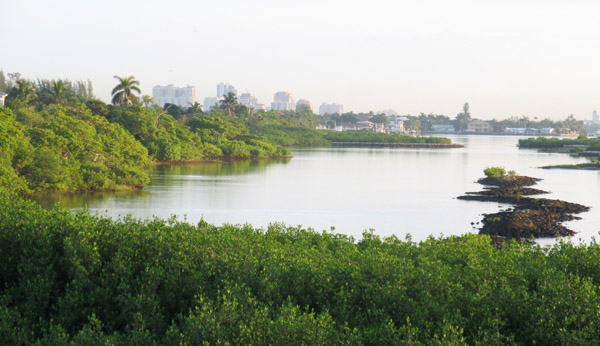Shoreline Habitat in the Intracoastal Waterway
Up until a few years ago, the wakes of passing boats in the Intracoastal Waterway lapped up against the bare shoreline and seawall of the public golf course and the adjacent Bryant Park without any interferance. Now in several areas, where new living shorelines* have been installed, the wakes don't hit the seawall at all, but are absorbed by the new mangrove-covered extenstions to the seawall and new islands. Several areas of cord grass (Spartina spp) have also been planted. There are 10 acres of mangrove and nearly 3 acreas of cord grass.
 |
| In this phase of the project, a public walkway, a kayak lanching dock, an artificial reef, and a new fishing pier are all being constructed along the new mangrove habitat. |
With all these efforts to improve the water quality, residents and guests alike will want to paddle their kayaks in Lake Worth Lagoon and even eat the fish that they catch there. Bird watchers will have much more to view now that a wide variety of water and shoreline birds have places to roost and fish.
| This photo is one of two panorama shots of the project. This one is closest to the Lake Avenue bridge and you can see a little of the golf course on the left. |
"The Spartina marsh will help stabilize sediments and filter nutrients out of the system, contributing to increased water quality. The rock revetment will serve to protect the planted areas and also act as a shallow water reef that is conducive as a substratum for oysters and other attaching organisms. Funding partners include PBC, FIND, USACOE, SFWMD, FDEP & FWC." Quoted from Lake Worth Lagoon Habitat Restoration and Stormwater Projects. Impressive!
This is a fantastic project supported by the cooperation of various public, private, and volunteer organizations. Does your community have a sinilar project where habitat has been created and water quality has been improved?
For more information:
SunSentenial article: "Mangrove project is bringing Lake Worth Lagoon back to health"
Palm Beach County: "The Snook Islands Natural Area" includes several fact sheets including this summary of all the related Palm Beach County Projects: Lake Worth Lagoon Habitat Restoration and Stormwater Projects.
Too much of Florida's original shoreline vegetation has been replaced with bulkheads, seawalls and rock riprap, which create a hard shoreline with little habitat for fish, birds, shellfish, and other wildlife. The water-side plants create a buffer that acts like a sponge that will blunt the exposure to wave action (from storms and boats) and water flows. These waterside plants also absorb nutrients from the water and create habitat for oysters and other filter feeders that will further clean the water.
While this Palm Beach County project is huge, even small projects or installations of appropriate shoreline plants outside of a bulkhead or riprap can make a difference. A little bit of habitat will build into more as your plants will trap more sediment and as birds and other wildlife start to visit or live in the newly created habitat and deposit their fertilizer and new seeds. You can add to your shoreline habitat over the years and when you have the time and energy.
For the first few years, you'll need to monitor the area for invasive species like Australian pine and Brazilian pepper, but eventually the mangroves and cord grass will become so thick that those invasives will be less of a problem. Be sure to check with your local authorities before you start a living shoreline project.
Ginny Stibolt







Comments
V. Avery